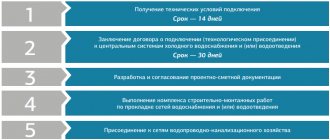Limits of operational responsibility
Understanding the boundaries of responsibility between the RSO, the management company and the owners of residential premises in apartment buildings is important to avoid controversial situations. In judicial practice, there are often cases of disputes between the RSO and the management company regarding operational responsibility for certain sections of utility networks, regarding which no agreement has been reached. In half of administrative cases of this kind, the court takes the side of the RSO, in this case the Criminal Code incurs large losses. To avoid this and be insured against unwanted conflicts, you need to draw up an act of delimitation of responsibility.
Limits of operational responsibility
Not for all corporate entities the legislation clearly defines the boundaries of operational responsibility and the balance sheet inextricably linked with it. These concepts are most clearly presented in clause 1 of the Rules for cold water supply and sanitation (Resolution of the Government of the Russian Federation No. 644).
According to this document, the boundary of the balance sheet is recognized as the boundary of the division of property. It, in turn, determines the boundary of operational responsibility, that is, it indicates who will bear the burden of maintaining the facility: the management organization, the RSO or the owners. The same can be said about other communal resources. Responsibility for heat supply is distributed as follows: RSO bears responsibility up to the point of connection of the common house metering device with the heating network included in the apartment building. The management company is responsible for the heating system risers, disconnecting devices on branches from the risers and for shut-off and control valves on the intra-apartment wiring. Residents' responsibility again begins inside their home, they are responsible for heating devices and for branches from the heating system risers after the shut-off and control valves.
Management companies are required to monitor the condition of hot and cold water supply risers, shut-off devices on branches from risers and shut-off and control valves on intra-apartment wiring. The owners of premises in apartment buildings are responsible for the branches from the risers of the hot and cold water supply system after the shut-off and control valves, for the shut-off and control valves themselves and for the plumbing equipment in the apartments.
In a resource supply agreement, the balance sheet boundary separates utility networks, which are common property (Article 36 of the Housing Code of the Russian Federation), from other utility networks. Therefore, let us remind you what applies to common property (Resolution of the Government of the Russian Federation No. 491, Article 36 of the Housing Code of the Russian Federation): - premises in apartment buildings that are not parts of apartments and are intended to serve more than one residential/non-residential premises in the house; — in-house engineering systems for cold and hot water supply, gas supply, heating and electricity supply. The boundaries of operational responsibility can be external and internal. In the first case, they share the spheres of competence of the RSO and the management company (the external border of the wall of the apartment building), in the second - the management company and the owners (the internal border of the wall of the apartment building).
Source: RosKvartal® - Internet service No. 1 for management organizations https://roskvartal.ru/dogovor-uk-s-rso/6724/granicy-ekspluatacionnoy-otvetstvennosti
Consulting housing and communal services/homeowners association/residential property management
One of the most painful issues when concluding contracts with resource supply organizations (RSOs) for HOAs, housing cooperatives and management companies is the delimitation of so-called operational responsibility and the definition of its boundaries. Practice shows that for HOAs and housing cooperatives, this issue often becomes relevant when accidents occur on networks that are not related to the common property of the owners in an apartment building, when, due to a recklessly signed agreement, the responsibility for repairing these networks is assigned to the HOA and housing cooperatives.
Additional meters of engineering communications impose on the management organization (and therefore on the owners of apartment building premises) an additional financial burden for their maintenance and repair, which is sometimes beyond the power of the HOA, and also imply inevitable costs to cover losses of communal resources.
Regulatory regulation
When considering this issue, you should first of all turn to the Civil Code, which governs all energy supply contracts. According to Art. 539 of the Civil Code of the Russian Federation, under an energy supply agreement, the energy supplying organization undertakes to supply energy to the subscriber (consumer) through the connected network, and the subscriber undertakes to pay for the received energy, as well as to comply with the regime of its consumption stipulated in the agreement, to ensure the safe operation of the energy networks under its control and the serviceability of the devices used by it and equipment related to energy consumption. An energy supply contract is concluded with the subscriber if he has a power receiving device that meets the established technical requirements, connected to the networks of the energy supply organization, and other necessary equipment, as well as providing metering of energy consumption.
The general provisions of the Civil Code of the Russian Federation regarding the boundaries of operational responsibility have been developed in such regulations as: Federal Law of March 26, 2003 No. 35-FZ “On Electric Power Industry”; Rules for the functioning of retail electricity markets during the transition period of the formation of the electric power industry, approved. Decree of the Government of the Russian Federation dated August 31, 2006 No. 530 (hereinafter referred to as the Electric Power Industry Rules); Rules for non-discriminatory access to electric energy transmission services and the provision of these services, approved. Decree of the Government of the Russian Federation dated December 27, 2004 No. 861 (hereinafter referred to as the Access Rules); Rules for the use of public water supply and sewerage systems in the Russian Federation, approved. Decree of the Government of the Russian Federation dated February 12, 1999 No. 167 ( as amended on July 29, 2013) (hereinafter referred to as the Water Supply Rules); Rules for maintaining common property in an apartment building, approved. Decree of the Government of the Russian Federation dated August 13, 2006 No. 491; ( as amended on May 14, 2013 ) Circular letter of the State Construction Committee of Russia dated October 14, 1999 No. LCH-3555/12 “On clarifications on the application of the Rules for the use of public water supply and sewerage systems in the Russian Federation.” ( The text of the letter was not officially published)
Operational responsibility and balance sheet ownership
Basic concepts. In the listed acts, the concept of the boundaries of operational responsibility invariably stands next to the concept of the boundaries of balance sheet ownership, while a general definition for neither one nor the other is not enshrined in the legislation. Meanwhile, there are a number of definitions within the framework of regulation of various energy supply contracts. Thus, in accordance with clause 1 of the Water Supply Rules: the balance sheet boundary is the line dividing elements of water supply and (or) sewerage systems and structures on them between owners on the basis of ownership, economic management or operational management; operational responsibility boundary - the line dividing elements of water supply and (or) sewerage systems (water supply and sewerage networks and structures on them) on the basis of duties (responsibility) for the operation of elements of water supply and (or) sewerage systems, established by agreement of the parties. In the absence of such an agreement, the boundary of operational responsibility is established along the line of balance sheet ownership. Regarding the supply of thermal energy, there is no such definition at all, but paragraph 31 of the letter of the Federal Tariff Service of Russia dated 02.18.2005 No. SN-570/14 states that supplied thermal energy is thermal energy supplied to the thermal energy consumer (consumers) at the boundary of operational responsibility ( balance sheet).
The most complete definitions of the concepts under consideration relate to the supply of electrical energy. According to clause 2 of the Access Rules: an act of delimitation of balance sheet ownership of electric networks - a document drawn up in the process of technological connection of energy receiving devices (power installations) of individuals and legal entities to electric networks, defining the boundaries of balance sheet ownership; act of delimitation of operational responsibilities of the parties - a document drawn up by the network organization and the consumer of services for the transmission of electrical energy in the process of technological connection of power receiving devices, defining the boundaries of responsibility of the parties for the operation of the corresponding power receiving devices and power grid facilities; balance sheet line of ownership - the line of dividing electric power facilities between owners on the basis of ownership or possession on another basis provided for by federal laws, defining the boundary of operational responsibility between the network organization and the consumer of electric energy transmission services (the consumer of electric energy in whose interests an agreement for the provision of electric energy services is concluded transmission of electrical energy) for the condition and maintenance of electrical installations.
From the analysis of legal acts it follows that the line of balance sheet ownership divides utility networks based on ownership or other legal possession, and the line of operational responsibility presupposes a dividing line based on the burden of maintaining utility lines.
When concluding resource supply agreements for apartment buildings, the balance sheet boundary will separate the utility networks, which are the common property of the owners of the premises (Article 36 of the Housing Code of the Russian Federation), from other utility networks. In this regard, it is important to understand what belongs to common property.
According to clause 5 of the Rules for the maintenance of common property, the common property includes in-house engineering systems of cold and hot water supply and gas supply, consisting of risers, branches from the risers to the first disconnecting device located on the branches from the risers of the specified disconnecting devices, collective (common house) metering devices cold and hot water, the first shut-off and control valves on the branches of the intra-apartment wiring from the risers, as well as mechanical, electrical, sanitary and other equipment located on these networks.
The common property includes an intra-house power supply system, including networks (cables) from the external boundary established in accordance with clause 8 of these Rules, to individual, common (apartment) electrical energy meters, as well as other electrical equipment located on these networks (clause 7 of the Rules for the maintenance of common property).
By virtue of clause 8 of the rules under consideration, the outer boundary of electricity, heat, water supply and sewerage networks, information and telecommunication networks (including wired radio broadcasting networks, cable television, fiber optic networks, telephone lines and other similar networks) included the composition of the common property, unless otherwise established by the legislation of the Russian Federation, is the outer boundary of the wall of an apartment building, and the limit of operational responsibility in the presence of a collective (common house) metering device for the corresponding communal resource, unless otherwise provided by an agreement between the owners of the premises and the provider of utilities or RSO, is the point of connection of the collective (general house) metering device with the corresponding engineering network included in the apartment building. The outer boundary of the gas supply networks that are part of the common property is the point of connection of the first shut-off device with the external gas distribution network (clause 9 of the Rules for the maintenance of common property).
Thus, the boundary of balance sheet ownership when concluding resource supply agreements for apartment buildings is always the external boundary of the wall of such a house, and the boundary of operational responsibility is not established imperatively - it can: be established by agreement of the parties; coincide with the point of connection of the collective (common building) metering device with the corresponding utility network included in the apartment building; coincide with the border of the balance sheet (for owners of apartment buildings this is the external wall of the house).
Thus, specifying clause 8 of the Rules for the maintenance of common property, you can refer to clause 14 of the Water Supply Rules, which states: if there is agreement, the delimitation can be established along the well (or chamber) to which devices and structures are connected to connect the subscriber to the public water supply or sewer network. Regarding heating networks, it is possible to set the boundary of operational responsibility on the wall of the thermal chamber at the subscriber's input or at the first disconnecting devices (Resolution of the Federal Antimonopoly Service of the North Caucasus Region dated May 28, 2009 No. A53-9063/2008-C2-41). All of these options must be agreed upon in the act of delineating operational responsibilities.
Litigation
An analysis of legislation and judicial practice allows us to conclude that if there is no agreement between the management organization and the RSO on the issue of determining the boundary of operational responsibility, the latter is determined by the boundary of the balance sheet, which is the external wall of the apartment building.
The problematic issue is the need to sign this act. By virtue of Art. 543 of the Civil Code of the Russian Federation, the essential terms of the energy supply contract, without which the contract is void, include the condition of ensuring the maintenance and safe operation of networks, devices and equipment. By agreeing on the boundaries of operational responsibility, the parties provide for the procedure for the maintenance and operation of utility networks and equipment. The act of delineating operational responsibilities is a technical document, a form that allows reflecting such agreement. In addition, all the regulatory documents reviewed also require the signing of this act when concluding a resource supply agreement.
However, the act of delimiting operational responsibility takes place when an agreement is reached between the RSO and the subscriber on this issue, and if this is not achieved, the boundaries of responsibility are determined according to the boundaries of the balance sheet. Consequently, the act of delineating operational responsibilities may not always be present. The same is evidenced by the analysis of judicial practice on disputes about the terms of contracts that arise during their conclusion: courts sometimes even exclude from the text of the contract the appendices that contain this act.
So, we can draw the following conclusion: in the absence of an act of delimitation of operational responsibility, the boundary is established at the point of connection of the collective (common house) metering device, and in its absence - along the boundary of the common property of the owners of the apartment building premises.
In turn, the specified property may only include in-house life support systems that end with the outer boundary of the wall of the house and are intended to serve more than one room in a given house. Therefore, if the management organization is offered to take on the burden of responsibility for utility networks located outside the apartment building or serving more than one apartment building (regardless of location), then it can safely refuse and insist on establishing the boundaries of operational responsibility along the external wall of the house.
For example, the Sixth Arbitration Court of Appeal rejected the developer’s request to compel the management organization to accept external utility networks for power supply, storm drainage, and water supply sewerage for maintenance and maintenance. At the court hearing, it was established that these communications are intended to serve more than one residential and (or) non-residential premises in several apartment buildings, and not in one apartment building and, therefore, do not meet all the criteria established by law for the common property of an apartment building (resolution dated July 17 .2009 No. 06AP-2631/2009). Conversely, the management organization failed to prove the illegality of including thermal routes and hot water transit pipelines passing through the basements of houses, a hot water boiler in the basement of a house and other transit pipelines into municipal property (and their further lease to RSO). Despite the fact that these objects are located in the basement of an apartment building, they are not common property, since they serve more than one apartment building, and also since the external boundary of the wall of the house cannot be the boundary of transit heating networks (Resolution of the Federal Antimonopoly Service of Ukraine dated May 18, 2009 No. F09- 2962/09-C6).
In addition, as practice shows, problems when concluding an agreement and delineating operational responsibilities arise when the balance holder of the section of utility networks from the wall of the apartment building to the networks on the balance sheet of the RSO is not known. These plots are often ownerless, but necessary to supply the house with resources (and are located on the adjacent land plot, which is part of the common property). As a rule, RNOs try to place the burden of maintaining such sections of networks on the management organization and owners of apartment building premises, citing the fact that the maintenance of these sections is not taken into account in the tariffs. Meanwhile, even in this situation there are no legal grounds for delineating operational responsibilities for connecting to utility networks included in the balance sheet of the RSO. Let us stipulate once again that this provision is valid in the absence of an agreement of the parties expressed in the act, since by virtue of clause 1 of Art. 421 of the Civil Code of the Russian Federation, legal entities are free to enter into an agreement. According to paragraph 4 of this article, the terms of the agreement are determined at the discretion of the parties. The courts, when resolving these disputes, note that the RSO has the right to apply to the regulatory body with documents confirming the costs of paying for services for the transfer of resources over networks that were not transferred to it for operation, in order to account for them and compensate for them in the subsequent period of tariff regulation (FAS resolutions VBO dated March 24, 2009 No. A29-5292/2008, dated September 23, 2008 No. A11-11702/2007-K1-6/37).
When creating the material, the source was https://www.mcfr.ru
Who owns the external engineering networks built with the money of shareholders?
Federal Law of December 30, 2004 N 214-FZ “On participation in shared construction of apartment buildings and other real estate and on amendments to certain legislative acts of the Russian Federation” allows the Developer, at the expense of shareholders’ funds, to build external utility networks within the boundaries of the land plot, allocated for construction. However, the law says nothing about who owns these utility networks after the building is put into operation.
Distressed real estate
After completion of construction, developers are often faced with the question of what to do with the constructed communications located within the boundaries of the land plot allocated for construction.
· Can the Developer transfer utility networks to a management company?
· Does the Developer have the right to transfer utility networks for lease or ownership to a resource supply organization?
· Should taxes be charged when utility networks are transferred into the ownership of resource supply organizations?
These are only part of the questions that the developer must answer when deciding the fate of the utility networks remaining on his balance sheet. The answer depends on who owns the constructed networks. And with this there is just no clarity.
When shared networks are not common property
As a rule, shareholders become owners of utility networks by force of law. Article 36 of the Housing Code of the Russian Federation, Rules for the maintenance of common property in an apartment building, approved. Decree of the Government of the Russian Federation dated August 13, 2006 N 491 establishes a list of property that, according to the law, is the common property of all home owners. In particular, such property includes transformer substations, heating points and external networks that serve more than one room in the same house.
Difficulties in interpreting these standards arise when several houses are connected to transformer substations, heating points, storm sewers and other facilities. Will such objects have the status of common property by force of law?
An unequivocal conclusion follows from judicial practice: no, they won’t.
Indicative in this regard is the Resolution of the Presidium of the Supreme Arbitration Court of the Russian Federation dated December 15, 2009 N 14801/08 in case N A72-5489/06-22/219. In this case, the court was faced with a situation where a transit heating pipe passed through the basement of one house to another house. The owners of the first house argued that they are also the owners of the transit pipe, since it is located in their basement and heats their house, among other things. The owners of the second building objected that it did not matter whose basement it was, it did not affect the status of the pipe.
The Supreme Arbitration Court of the Russian Federation reviewed the case and answered that the owners of the second building were right. Within the meaning of paragraphs 5 and 6 of the Property Maintenance Rules, heating networks that provide not only an intra-house heating system, but also a system outside it, cannot be included in the common property of citizens living in an apartment building. The part of the basement heating networks that supplies heat to both a residential building and a separate building outside the house cannot be classified as common property.
An interesting conclusion follows from this: utility networks built with the money of shareholders, but serving more than one house, are not common property.
Ownerless property is a burden to the municipality
Developers often have a desire to transfer the constructed utility networks to the municipality. In some cases, this is acceptable and even the responsibility of the developer. Utility networks must be transferred to local governments in the following cases:
· Under an agreement on the development of a built-up area, if this is provided for in the agreement (clause 2, part 4, article 46.2 of the Town Planning Code of the Russian Federation);
· Under an agreement on the comprehensive development of the territory, if this is provided for in the agreement (clause 2, part 6, article 46.4 of the Town Planning Code of the Russian Federation);
· In accordance with the Moscow government decree of August 22, 2000 No. 660 “On the procedure for accepting engineering and public utility facilities into the ownership of the city of Moscow”;
· In Clause 7 of the Government of the Russian Federation of February 13, 2006 N 83 “On approval of the Rules for determining and providing technical conditions for connecting a capital construction project to engineering support networks and Rules for connecting a capital construction project to engineering support networks,” the government recommended that local authorities self-government to accept the engineering and technical support networks created at the expense of the legal owner of the land plot outside the boundaries of the land plot into municipal (state) ownership. However, this is a right, and not an obligation of the municipality, which, among other things, does not apply to utility networks created inside the land plot.
As you can see, the list is quite limited. This forces interested parties to contrive and try to transfer external networks to the municipality as ownerless property on the basis of Article 225 of the Civil Code of the Russian Federation.
An interesting position is set out in the Resolution of the Arbitration Court of the Far Eastern District dated May 19, 2015 in case No. A73-11133/2014. In this case, the court came to the conclusion that external utility networks, which are not common property, even if created during the construction of the building, are not the property of shareholders. The court actually recognized such networks as ownerless, but indicated that the City Hall had no obligation to take such networks into account.
Referring to the norms of paragraphs 5, 6 of Article 8 of the Federal Law of December 7, 2011 N 416-FZ “On Water Supply and Sanitation,” the court noted that resource supply organizations have the right to operate ownerless facilities of centralized cold water supply and (or) sewerage systems, and also determine the accounting procedure expenses incurred in this regard. Therefore, the resource supplying organization and the municipality must regulate the status of external networks. Home owners should not be concerned about this relationship.
This position is reminiscent of an ostrich hiding its head in the sand. It allows us to solve the problem from a practical point of view, but from a legal point of view it does not stand up to criticism. If someone built utility networks, it means they have an owner. And the court had to decide who it was.
Developer's burden
In accordance with Article 218 of the Civil Code of the Russian Federation, the right of ownership to a new thing manufactured or created by a person for himself in compliance with the law and other legal acts is acquired by that person.
The developer is interested in the construction of external utility networks and has the right to lease or own the site provided for construction. Based on these positions, the developer can be recognized as the owner of utility networks.
This provides certain advantages for the further circulation of utility networks, which now have a single owner who monitors their condition; if necessary, gives permission to connect to them; does not impose additional maintenance costs on the owners of premises in apartment buildings.
An interesting conclusion is set out in the Resolution of the Presidium of the Krasnoyarsk Regional Court dated June 26, 2018 in case No. 44G-71/2018, 44G-72/2018. The court began to interpret verbatim the share participation agreement, according to which the subject of the agreement was an apartment in the house, but not a transformer substation. The court took into account that the transformer substation is part of an electrical installation complex that provides power supply to the microdistrict via a ring network, i.e. is not common property. Based on this, the court recognized that the shareholders do not have rights to the transformer substation, the owner of which is the developer.
There are a number of objections to this approach:
1. After completion of construction, the land plot goes to the shareholders. There are exceptions to this rule when, for example, a plot of land is allocated specifically for the construction of a transformer substation;
2. Utility networks can be built at the expense of shareholders. The transfer of such utility networks to the developer can be considered as a kind of donation of funds;
3. The developer does not build utility networks for their further operation. In some cases, developers create subsidiaries that further service the houses built by the developer. If the developer is not going to maintain the houses either himself or through a controlled management company, then how justified is it to place on him the burden of maintaining the utilities that the owners of the premises in the house need.
For many developers, utilities are a burden that they do not want to incur.
Common property of owners of several houses
We are back to where we started - can the owners of common utility networks be the shareholders of all houses that are connected to these utility networks? If there are two houses, then the shareholders of two houses own and belong to these utility networks. If there are three houses, then the shareholders of three houses own the networks. And if your storm sewer serves ten houses, then all ten thousand residents are the owners of this storm sewer.
This conclusion follows smoothly from Article 18.1 of the law on equity participation. According to this norm, objects of a social structure that serve several houses can, by agreement, be transferred to shared ownership by all owners. Of course, first of all, the law understands social infrastructure facilities as schools, kindergartens, and clinics, although the question of the possibility of transferring such facilities to shareholders raises even more questions. But it seems that these may include transformer substations, other utility networks, and even roads.
For the application of Article 18.1. There are a number of conditions. At a minimum, an appropriate agreement must be concluded with the shareholder. I am not aware of the signing of such agreements.
It can be insisted that the developer’s failure to comply with the obligation to conclude appropriate agreements with the shareholder does not deprive the latter of the right of ownership to the utility networks created on their land plot, at their expense and for their needs.
In my experience, there was a case when a developer decided to transfer a transformer substation to the balance of the management company as the common property of all shareholders, guided precisely by the fact that it was built at the expense of the shareholders of several houses. The peculiarity of the civil circulation of engineering networks and linear objects made it possible to do this without state registration of property rights.
But do shareholders themselves need such “joy” in the form of registration of property rights? After registration, shareholders become the owner of an independent property. It is not common property that follows the fate of the main thing. If the owner has sold the apartment, then he must sell one thousandth share in the ownership of the transformer substation, subject to the pre-emptive right of purchase by other shareholders. The procedure can be bypassed by donating the share to the new owner. In any case, you will have to pay an additional state fee and persuade the new owner to accept the “gift”. The defense capability of the apartment becomes more complicated.
Then even more questions arise. Are you a shareholder and want the transformer substation to be serviced by a management company? Convene a general meeting of owners of all houses. It’s good if there is one management company for several houses. You can collect signatures on the lease of infrastructure facilities to resource supply organizations, if they are not against it, but who will sign such an agreement on behalf of the owners? It's even worse if you need to join a storm sewer that has ten thousand owners. To do this, it will be necessary to collect signatures from at least two thirds of them.
Here it is appropriate to create a separate administration that will service separate engineering networks. Transformer substation maintenance department. Bike Path Maintenance Department. People's bodies of local self-government, which will begin to duplicate the functions of local governments on a local scale. One could laugh at this if there were no real problem behind this irony.
Disappointing conclusions
Today, there is a whole layer of relations in the field of urban planning and public services that is in the field of legal uncertainty. Huge quantities of utility networks with an unclear status that may fail, require repairs, and need to be used to connect new houses and buildings to them. And the same uncertain judicial practice, which does not know what to do with these utility networks, offering new options each time. Stability and certainty of civil circulation requires a final solution to this issue, which will take into account the interests of all parties and not create unjustified difficulties in the disposal and use of utility networks. If there is property, there must be an owner.
Area of responsibility of the electricity supply management company
If we talk about the boundaries of responsibility affecting the cold water and hot water systems, as well as the gas pipeline, then they must pass along the branch of the pipeline from the transit line (riser) along the initial connecting thread at the entrance of such a pipe into the housing.
In the power supply system of an apartment building, the limit of responsibility for the owners is determined by the outgoing terminals of the input switch for the apartment, and if the latter is absent, then by the input terminals of the individual electricity meter.
The general sewer system of the house (drainage system) contains transit-type risers; for this reason, the line of responsibility lies at the point where the sewerage system inside the apartment is connected to the specified riser.
Social factor
Info
Many owners of city apartments suspect that their management companies are guided by the “out of the blue” rule when issuing bills for maintenance and repairs. So why are they responsible for our money {q} Why do we pay “utilities” Almost all owners of residential premises in apartment buildings sooner or later face problems with repairs. When you contact the Management Company servicing the house, you can easily obtain a price list for its employees to carry out certain work.
Info
If the management company tries to obtain an additional payment for these services or misleads the applicant and refuses to provide them, then such actions are a direct violation of the Law “On the Protection of Consumer Rights” and Article 310 of the Civil Code of the Russian Federation. In this case, the citizen has the right to submit a written claim indicating his requirements, a complaint to the State Housing Inspectorate, and subsequently file a claim in court and receive up to 50% of the amount of the fine awarded to the Management Company.
In reality, unfortunately, not everything is so simple. Banal legal inexperience puts the homeowner in a deliberately unequal position in relation to management companies who are experienced in such matters and have their own staff of lawyers. This reduces the chances of a positive outcome of the case even in the case of seemingly obvious violations on the part of the Criminal Code.
Contents of acts of delimitation and responsibility
Completing the document correctly is very important.
If even one mistake is made, the document cannot be recognized as valid, which means it will not have any power. But if you are not a professional lawyer, then do not worry, because the form of this document is quite simple. You don’t even have to download the form, but fill out the paper yourself in simple written form.
Both sample documents must contain the following information:
- Personal information about the parties to the transaction:
- Name of enterprises;
- Full names of representatives of these companies;
- Passport information of citizens.
- A list of points of different water supply and sanitation systems, as well as points of connection of technical equipment that tracks the amount of resources spent;
- An accurate and complete description of the powers vested in each party.
- A schematic description of all communications that become partly owned by the second party;
- Other information necessary to clarify other nuances regarding certain circumstances. Also, this paragraph specifies other circumstances of the transaction that reveal the circumstances of the powers granted.
How to draw up a sample act of delimitation
An act is a document that is drawn up in writing to designate the rights, obligations and powers between organizations supplying resources and the subscriber who receives them. Although the second party can also be a management company, which is only an intermediary, taking over some of the responsibilities after the form is signed.
The responsibilities of supplier companies are not so extensive. In particular, these companies are obliged to supply the resource in the required quantity and in high quality. But for the subscriber, who is now the management company, delivery of the service costs a pretty penny. The point is that he must:
- Repair equipment if it breaks;
- Carry out equipment maintenance;
- Other responsibilities.
In the act, these conditions are indicated in a separate section of the act, therefore they need to be drawn up and discussed so as not to end up with cases in court, defending your “infringed” interests
In addition, when drawing up the act, you need to pay attention to the following:
- First of all, the form of the act must be supported by documents. The following documents are sent to the supplier company:
- Title documents for the house;
- Construction permits;
- Permission to put the house into operation.
- Conclude an agreement to ensure the operation of sewer networks, indicating in it all the nuances and features of the future transaction.
- Sign the relevant act, which will guarantee the fulfillment of powers by the parties.
The document indicates the layout of the networks. But what is more useful is that there is information here about who is responsible for which branch of the water supply system. A sample is drawn up in triplicate. One of them remains with the client, the second with the service provider, and the third will be transferred to the representative office of the government agency.










